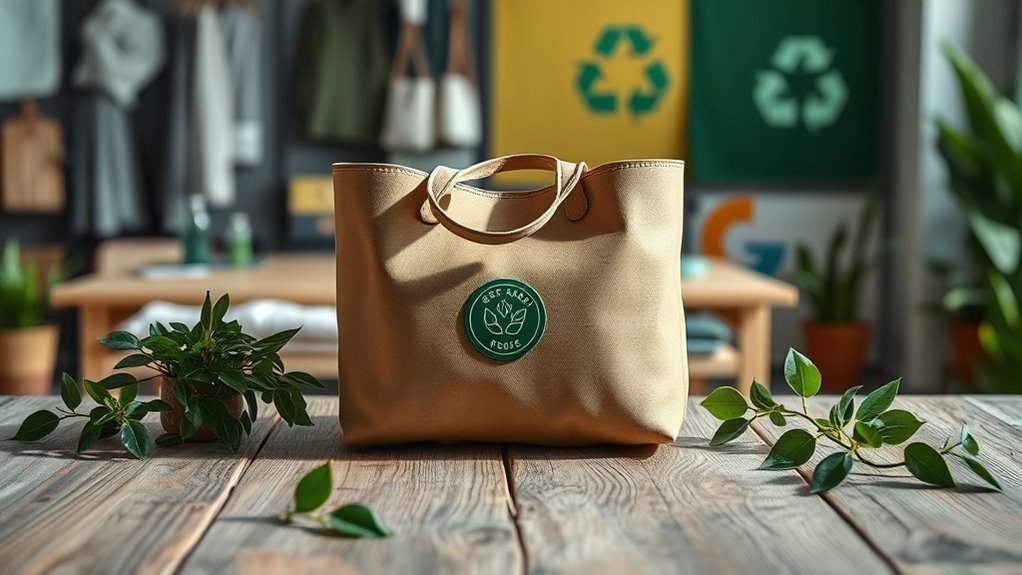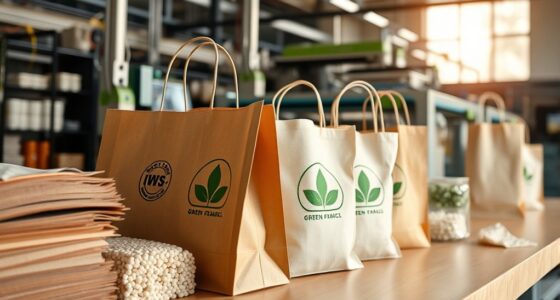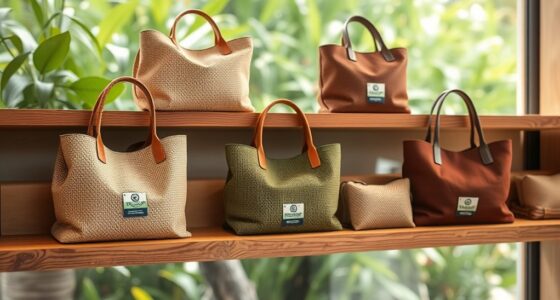You can see the bag industry embracing circular fashion by sourcing sustainable materials like recycled plastics and organic textiles, which reduce environmental impact. Many brands are implementing end-of-life programs such as take-back schemes and designing modular, biodegradable products to extend lifespans and promote recycling. These initiatives also involve educating consumers on proper disposal and encouraging responsible participation. To discover how these efforts are shaping the future of eco-friendly bags, keep exploring these innovative strategies and collaborations.
Key Takeaways
- Many brands are adopting sustainable materials like recycled plastics and plant-based textiles to reduce environmental impact.
- End-of-life programs, including take-back schemes and modular designs, promote product reuse and recycling in the bag industry.
- Consumer education initiatives encourage proper disposal, recycling, and participation in sustainable practices for eco-friendly bag lifecycle management.
- Industry collaborations with recycling facilities and research investments aim to create closed-loop systems for bag production and disposal.
- Overall, circular fashion initiatives focus on responsible sourcing, extending product lifespan, and fostering industry-wide environmental responsibility.

Have you ever wondered how the bag industry is adapting to sustainability? It’s a question many consumers are asking as environmental concerns grow and demand for eco-friendly products rises. The industry is making strides by focusing on sustainable material sourcing, which means choosing raw materials that have a lower environmental footprint. Instead of relying solely on traditional leather, plastic, or synthetic fabrics, brands are turning to innovative options like recycled plastics, organic textiles, and plant-based materials. These choices help reduce dependency on fossil fuels, cut down greenhouse gas emissions, and support responsible harvesting practices. By prioritizing sustainable material sourcing, companies aim to create products that are both stylish and environmentally friendly, appealing to eco-conscious consumers who want to make a positive impact with their purchases.
But it’s not just about where the materials come from; the industry is also working on end of life product programs. These programs are designed to extend the lifespan of bags and guarantee they don’t end up in landfills prematurely. Brands are implementing take-back schemes, where customers can return their old bags for recycling or refurbishment. Some companies are developing modular designs that allow parts to be replaced or upgraded, reducing the need to buy new bags altogether. Others are exploring biodegradable or compostable materials that break down naturally after disposal, minimizing environmental harm. These initiatives reflect a shift toward viewing products as part of a circular economy, where waste is minimized and resources are reused. Additionally, some brands are educating consumers on the benefits of recycling and responsible disposal, encouraging active participation in sustainable practices.
Incorporating end of life product programs requires a strategic approach. It involves educating consumers on how to properly care for and dispose of their bags and establishing partnerships with recycling facilities. Brands are also investing in research to develop new materials that can be easily recycled or repurposed, making the entire lifecycle of the product more sustainable. The goal is to create a closed-loop system where the bag’s journey from production to disposal is responsible and eco-friendly. As a consumer, your role becomes even more vital—you can support brands that prioritize sustainable material sourcing and participate in end of life programs by returning or recycling your bags.
Frequently Asked Questions
How Do Circular Bag Initiatives Impact Pricing Strategies?
Circular bag initiatives impact your pricing strategies by prompting supply chain adjustments, which can increase production costs but also add value through sustainability. You might need to set higher prices to cover these costs or position your brand as eco-friendly, influencing branding implications. Balancing affordability with premium perception becomes key, as consumers increasingly prioritize sustainable choices. Ultimately, these initiatives encourage you to innovate your pricing to reflect environmental commitments and supply chain efficiencies.
What Consumer Behaviors Drive Success in Circular Bag Programs?
You’re more likely to succeed in circular bag programs if you actively foster consumer engagement and offer compelling reuse incentives. When customers see value in participating—like discounts or rewards for returning bags—they become motivated to reuse and support sustainability. This behavior creates a cycle of loyalty, making circular initiatives thrive. By understanding and tapping into these motivations, you turn eco-conscious choices into a natural part of your consumers’ habits.
Are There Specific Materials Best Suited for Circular Bag Designs?
You should focus on using sustainable textiles like recycled fabrics or organic materials for circular bag designs, as they promote longevity and reduce environmental impact. Additionally, eco-friendly dyes are essential because they minimize pollution and are safer for both producers and consumers. These materials guarantee your bags are truly sustainable, making them more attractive to eco-conscious customers and enhancing the overall success of your circular fashion initiatives.
How Do Brands Ensure Durability in Recycled or Upcycled Bags?
You guarantee durability in recycled or upcycled bags by prioritizing material longevity and design resilience. Choose high-quality, durable materials that withstand wear and tear, even after multiple uses. Incorporate reinforced stitching and sturdy hardware to enhance structural integrity. Regular testing and quality checks also help confirm the bag’s resilience. By focusing on these aspects, you create sustainable bags that last longer, reducing waste and supporting circular fashion principles.
What Legal Regulations Affect Circular Bag Initiatives Globally?
You might be surprised, but legal regulations like sustainability certifications and waste management policies shape your circular bag initiatives worldwide. These rules guarantee responsible sourcing, proper waste disposal, and environmental accountability. Countries enforce different standards, creating a complex web of compliance. Staying updated on local and international laws helps you navigate these regulations, ensuring your eco-friendly efforts meet legal demands and gain consumer trust, ultimately reinforcing your commitment to sustainability.
Conclusion
As you walk through the evolving landscape of the bag industry, imagine bags that breathe new life with each use—woven from recycled materials, designed to be loved and repurposed. Circular fashion initiatives are transforming your choices into acts of sustainability, turning discarded materials into stylish statements. Embrace this movement, where your bags tell a story of innovation and care for the planet, making every purchase a step toward a more sustainable, vibrant future.









